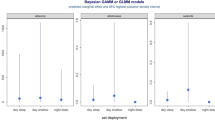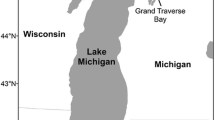Abstract
A Poisson catch rate model for striped bass (Morone saxatilis) anglers in Chesapeake Bay was developed that incorporates the effect of bottom temperature and dissolved oxygen (DO). Angler catch rates are shown to be negatively affected by low DO. Predicted angler catch rates were then used in a random utility model of striped bass fishing location choice. Where anglers choose to fish is significantly related to expected catch rate and the travel cost and time from the anglers residence to the fishing location. Results from the random utility model were then used to simulate the economic welfare changes that result from changing DO levels in the Patuxent River. Since there are many substitute sites for fishing in the Patuxent River, the welfare effects are small. Increases in DO from current levels have a small effect on angler welfare, but if levels are allowed to deteriorate so they never exceed 5 mg l−1, the welfare effects are much larger. Under this latter scenario, the net present value of angler losses exceeds $100,000, and are almost $300,000 if the fishing grounds are anoxic. Losses are considerably higher as the area impacted by low oxygen conditions increases.
Similar content being viewed by others
Literature cited
Bockstael, N. E., W. M. Hanemann, andI. E. Strand. 1989a. Measuring the benefits of water quality improvements using recreation demand models. Cooperative Agreement CR-81143-01-1. Environmental Protection Agency, Washington, D.C.
Bockstael, N. E., K. E. McConnell, andI. E. Strand. 1989b. Measuring the benefits of improvements in water quality: The Chesapeake Bay.Marine Resource Economics 6:1–18.
Brandt, S. B., D. M. Mason, andP. E. Vincent. 1992. Spatially-explicit models of fish growth rate.Fisheries 17:23–33.
Breitburg, D. L., N. Steinberg, S. DuBeau, C. Cooksey, andE. D. Houde. 1994. Effects of low dissolved oxygen on predation on estuarine fish larvae.Marine Ecology Progress Series 104:235–246.
Breitburg, D. L., T. Lober, C. A. Pacey, andA. Gerstein. 1997. Varying effects of low dissolved oxygen on trophic interactions in an estuarine food web.Ecological Monographs 67:489–507.
Coutant, C. C. 1985. Striped bass, temperature, and dissolved oxygen: A speculative hypothesis for environmental risk.Transactions of the American Fisheries Society 114:31–61.
Freeman, R. 1995. The benefits of water quality improvements for marine recreation: A review of the empirical evidence.Marine Resource Economics 10:385–406.
Hanemann, W. M. 1982. Applied welfare analysis with qualitative response models. California Agricultural Experiment Station Working Paper No. 241. University of California, Berkeley, California.
Hill, L. G., G. D. Schnell, andW. J. Mathews. 1981. Locomotor responses of the striped bass,Morone saxatilis, to environmental variables.American Midland Naturalist 105:139–148.
Kaoru, Y., V. K. Smith, andJ. L. Liu. 1995. Using random utility models to estimate the recreational value of estuarine resources.American Journal of Agricultural Economics 77:141–151.
Lipton, D. W. and R. Hicks. 1999. Linking water quality improvements to recreational fishing values: The case of Chesapeake Bay striped bass, p. 105–110.In T. J. Pitcher (ed.), Evaluating the Benefits of Recreational Fisheries. Fisheries Centre Research Reports 7(2), University of British Columbia.
McConnell, K. E. andI. E. Strand. 1994. The economic value of Mid and South Atlantic sportfishing, Volume 2. Report on Cooperative Agreement #CR-811043-01-0 between the University of Maryland College Park, the Environmental Protection Agency, the National Marine Fisheries Service, and the National Oceanic and Atmospheric Administration. Department of Agricultural and Resource Economics, College Park, Maryland.
McConnell, K. E., I. E. Strand, andL. Blake-Hedges. 1995. Random utility models of recreational fishing: Catching fish using a Poisson process.Marine Resource Economics 10:247–261.
McFadden, D. 1974. The measurement of urban travel demand.Journal of Public Economics 3:303–328.
Morey, E. R., R. D. Rowe, andM. Watson. 1993. A repeated nested-logit model of Atlantic salmon fishing.American Journal of Agricultural Economics 75:578–592.
Norton, V., T. Smith, andI. Strand. 1983. Stripers: The economic value of the Atlantic Coast commercial and recreational striped bass fisheries. UM-SG-TS-83-12. University of Maryland Sea Grant Program, College Park, Maryland.
Walsh, R. G., D. M. Johnson, andJ. R. McKean. 1992. Benefit transfer of outdoor recreation demand studies, 1968–1988.Water Resources Research 28:707–713.
Author information
Authors and Affiliations
Corresponding author
Rights and permissions
About this article
Cite this article
Lipton, D., Hicks, R. The cost of stress: Low dissolved oxygen and economic benefits of recreational striped bass (Morone saxatilis) fishing in the Patuxent River. Estuaries 26, 310–315 (2003). https://doi.org/10.1007/BF02695969
Received:
Accepted:
Issue Date:
DOI: https://doi.org/10.1007/BF02695969




